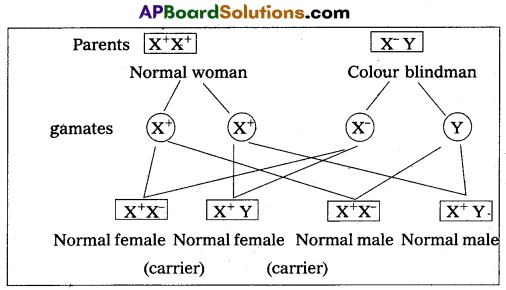Thoroughly analyzing AP Inter 2nd Year Zoology Model Papers and AP Inter 2nd Year Zoology Question Paper May 2017 helps students identify their strengths and weaknesses.
AP Inter 2nd Year Zoology Question Paper May 2017
Time: 3 Hours
Maximum Marks: 60
Instructions:
Note : Read the following instructions carefully.
- Answer all the questions of Section ‘A’. Answer any six questions in Section ‘B’ and answer any two questions in Section ‘C’.
- In Section ‘A’, questions from Sr. Nos. 1 to 10 are of Very Short Answer Type. Each question carries two marks. Every answer may be limited to 5 lines. Answer all the questions at one place in the same order.
- In Section B’, questions from Sr. Nos. 11 to 18 are of Short Answer Type. Each question carries four marks. Every answer may be limited to 20 lines.
- In Section ‘C’, questions from Sr. Nos. 19 to 21 are of Long Answer Type. Each question carries eight marks. Every answer may be limited to 60 lines.
- Draw labelled diagrams wherever necessary for questions in Sections ‘B’ and ‘C’.
Section – A (10 × 2 = 20)
Note : Answer all the questions in 5 lines each :
Question 1.
Name the different types of papillae present on the tongue of a man.
Answer:
The upper surface of the tongue has small projections called papillae. In humans the tongue bears 3 (three) types of papillae namely
- fungi form
- filiform.
- Circumvallate papillae.
Question 2.
Name the blood vessels that enter and exit the kidney.
Answer:
Renal artery enters kidney and renal vein comes out of the kidney.
![]()
Question 3.
Write the differences between actin and myosin.
Answer:
| Actin | Myosin |
| 1. Actin is a thin contractile protein. | 1. Myosin is a thick contra-ctile protein. |
| 2. It is present in light bands and is called an isotropic band. | 2. It is present in dark bands and is called an anisotropic band. |
| 3. Each actin filament is made of two ‘F’ actin molecules helically wound around each other, tropomyosin and a complex protein called troponin. | 3. Each myosin is made up of monomeric protein called meromyosins. Each mer- omyosin has two parts namely head, and arm (or) neck. |
Question 4.
Name the keystone bone of the cranium. Where is it located ?
Answer:
Sphenoid bone is the keystone bone of the cranium, because it articulates with all the other cranial bones. It is present at the middle part of the base of the skull.
Question 5.
“Colostrum is very much essential for the new bom infants”. Justify.
Answer:
The colostrum secreted by the mother during the initial days of lactation has abdundant IgA antibodies to protect infant from initial sources of infection.
Question 6.
Write the names of any four mononuclear phagocytes.
Answer:
- Histocytes – present in the connective tissue
- Kupffer cells – in the liver
- Microglia – in the brain
- Osteoclasts – in the bone.
Question 7.
What is amniocentesis ? Name any two disorders that can be detected by amniocentesis. .
Answer:
Amniocentesis is a diagnostic procedure to detect genetic defects in the unborn baby, in which amniotic fluid is collected from foetus and diagnosed for abnormalities. Down’s syndrome, Turner’s syndrome and Edward’s syndrome can be detected by amniocentesis.
Question 8.
What are the measures one has to take to prevent the contacting STDs ?
Answer:
The measures one has to be taken to prevent STDs are
a) Avoiding sex with unknown partners / multiple partners.
b) Using condoms compulsorily during coitus.
c) Consulting qualified doctor for early detection of STDs and getting complete treatment in case of infections.
Question 9.
List out any four features of cancer cells.
Answer:
- Loss of contact inhibition
- Reduced intra cellular adhesion
- Immortalization
- Loss of anchorage dependence
Question 10.
What is apiculture ?
Answer:
Apiculture is the maintenance of hives of honeybees for the production of honey and wax.
Apiculture is an age-old cottage industry.
![]()
Section – B (6 × 4 = 24)
Note : Answer any six questions in 20 lines each:
Question 11.
What are the functions of liver ?
Answer:
Liver performs a variety of functions such as synthesis, storage and secretion of various substances.
- Liver secretes bile juice, it contains bile salts such as sodium / potassium glycocholates and taurocholates, which helps in digestion and absorption of lipids.
- Liver plays the key role in carbohydrate metabolism.
a) Glycogenesis : formation of glycogen from glucose.
b) Glycogenolysis : breakdown of glycogen into glucose.
c) Gluconeogenesis : Synthesis of glucose from certain amino acids, lactate (or) glycerol. - Liver also plays an important role in synthesis of cholesterol and production of triglycerides.
- Deamination of proteins occurs in the liver.
- Liver is the chief organ of detoxification of toxic substances that enter the gut along with food.
- Liver acts as thermoregulatory organ.
- Liver acts as a haemopoietic organ in the foetus and erythroclastic organ in the adult.
- The liver synthesizes the plasma proteins such as albumin, globulins, blood clotting factors such as fibrinogen / prothrombin, etc., and the anticoagulant called heparin.
- The lactic acid formed during anaerobic muscle contraction is converted into glycogen (gluconeogenesis) in the liver by Cori cycle.
- Kupffer cells are the largest phagocytic cells whieh remove unwanted substances and microbes that attack the liver by phagocytosis.
Question 12.
What are the major transport mechanisms for CO2 ?
Explain.
Answer:
Carbondioxide is transported in three ways.
1. In dissolved state : 7% of CO2 is transported in dissolved state through plasma.
CO2 + H2O → H2CO3.
2. As Carbamino compounds : About 20-25% of CO2combine directly with free amino group of haemoglobin and forms Carbamino haemoglobin in a reversible manner.
Hb – NH2 + CO2 -> Hb- NHCOO– + H+.
pCO2 and pO2 could affect the binding of CO2 to haemoglobin.
- when pCO2 is high and pO2 is low as in the tissues, binding of more CO2 occurs.
- when pCO2 is low and pO2 is high as in the alveoli, dissociation of CO2 carbamino – haemoglobin takes place, (i.e., CO2 which is bound to haemoglobin from the tissues is delivered at the alveoli)
3. As Bicarbonates : About 70% of CO2 is transported as bicarbonate. RBCs contain a very high concentration of the enzyme, carbonic anhydrase and a minute quantity of the same is present in plasma too. This enzyme facilitates the following reaction in both the directions.

At the tissues where partial pressure of CO2 is high due to catabolism, CO2 diffuses into the blood and forms carbonic acid which dissociates into HCO–3 + H+
At the alveolar site where pCO2 is low, the reaction proceeds in the opposite direction leading to the formation of CO2 and water. Thus CO2 is mostly trapped as bicarbonate at the tissues and transported to the alveoli where it is dissociated out as CO2.
Every 100 ml of deoxygenated blood delivers approximately 4 ml of CO2 to the alveolar air.
Question 13.
Draw a labelled diagram of the T.S. of the spinal cord of a man.
Answer:
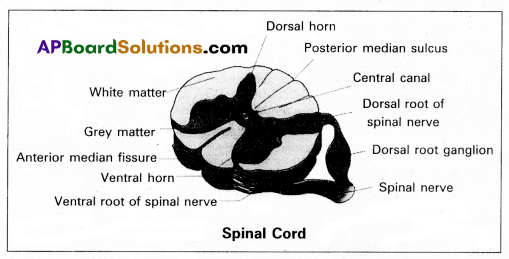
Question 14.
Explain how hypothyroidism and hyperthyroidism can affect the body.
Answer:
Hypothyroidism: Inadequate supply of iodine or impairment in the function of thyroid glands leads to decrease in production of thyroid hormones (T3 & T4) results in hypothyroidism and enlargement of the thyroid gland called Simple goiter.
During pregnancy due to hypothyroidism, defective development of the growing body leads to a disorder called Cretinism. Physical and mental growth gets severely stunted due to untreated congenital hypothyroidism, stunted growth, mental retardation, low IQ, deafness and mutism are some characteristics features of this disease.
In adult women it may cause irregular menstrual cycles. Hypothyroidism in adult causes Myxoedema characterized by bagginess under the eyes, puffiness of face, dry skin, slowness in physical and mental activities.
Hyperthyroidism : Over activity of thyroid, cancer of the gland or development of nodule of thyroid lead to hyper thyroidism. In adults it causes an abnormal growth leads to a disease called Exophthalmic goiter with characteristically protruded eyeballs. Hyperthyroidism also affects the physiology of the body i.e., increased metabolic rate, nervousness, rapid heartbeat, sweating, increased appetite etc.
![]()
Question 15.
Describe erythroblastosis foetalis.
Answer:
Erythroblastosis foetalis develops in an Rh positive foetus, whose father is Rh positive and mother is Rh negative. In Rh positive person rhesus antigens are present on the surface of blood cells where as in Rh negative person Rhesus antigens are absent.
During the process of delivery, the foetal blood cells may pass through the ruptured placenta into the Rh negative maternal blood. The mother’s immune system recognises the Rh antigens and gets sensitized and produces Rh antibodies. These antibodies are Ig G type they can pass through placenta. Generally first child is not effected because child is delivered by the time of the mother gets sensitized and produce antibodies.
During second pregnancy, if the second child is Rh positive, these antibodies cross the placenta, enter the foetal blood circulation and destroy the Rh positive blood cell of foetus (haemolysis), leads to haemolytic anemia and jaundice. To compensate the haemolysis of blood cells there is a rapid production of RBC’s from the bone marrow, and but also from liver and spleen. Now many large and immature blood cells in erythroblast stage are released into circulation. Because of this disease is called erythroblastosis foetalis.
Question 16.
Distinguish between homologous and analogous organs.
Answer:
1. Homologous organs : The organs which have similar structure and origin but not necessarily the same function are called homologous organs. Eg: The appendages of vertebrates such as the flippers of whale, wings of bat, forelimbs of horse, paw of cat and hands of man have a common pattern in the arrangement of bones even though their external form and functions may vary to suit their mode of life.
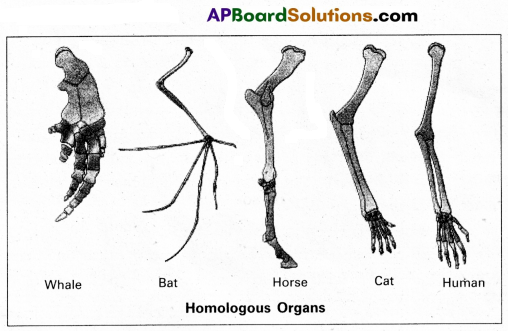
2. Analogous organs : The organs which have dissimilar structure and origin but perform the same function are called the analogous organs. Eg : Wings of butterfly and wings of a bird.
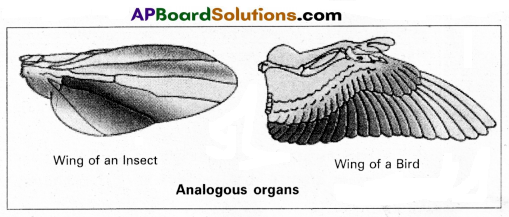
Question 17.
Explain Darwin’s theory of Natural Selection with industrial melanism as an experimental proof.
Answer:
Darwin’s theory of natural selection does not explain what exactly evolution is, but explains how evolution might have occurred in nature. A classical example for natural selection is industrial melanism, exhibited by peppered moth-Biston betularia. These moths were available in two colours grey and black. Grey moths were abundant before industrial revolution in all over England. The reason for the existence of large number of grey moths during that period was camouflage on the trunks of trees. But after the establishment of industries in England, black coloured moths were more and grey forms were less. This is due to pollution from industries in the form of soot turned barks of trees into black. So grey moths were easily identified and were more predated by birds. Thus grey moths decreased in number, black moths increased in the population.
Thus natural selection favoured the melanic moths (black) to reproduce more successfully. Natural selection of darker forms in response to industrial pollution is known as industrial melanism.
Question 18.
Write about the procedure involved in MRI.
Answer:
MRI Scan is a diagnostic radiology technique that uses magnetism, radiowaves and a computer to produce images of body components.
Procedure : MRI Scanner is giant circular magnetic tube.
- The patient is placed on a movable bed that is inserted into the magnet.
- Human body is mainly composed of water which contains two protons.
- The magnet creates a strong magnetic field that makes these proton align with the direction of the magnetic field.
- A second radiofrequency electromagnetic field is then , turned on for a brief period. The protons absorb some energy from these radio waves.
- When this second radio frequency emitting field is turned off, the protons release energy at a radio frequency which can be detected by the MRI scanner.
- Different types of tissues emit different quanta of energy. Abnormal tissues such as tumors can be detected because the protons in different types of tissues return to their equilibrium state at different rates.
- Tissues of bone with less water content look different in MRI, and pathological tissues also can be detected.
The information received is processed by computer and generated an image.
Section – C (2 × 8 = 16)
Note : Answer any two questions in 60 lines each:
Question 19.
Write a note on the working of the heart of a man.
Answer:
The human heart is an organ that provides a continuous blood circulation through the cardiac cycle.
Special conducting tissues of heart : Human heart is myogenic. It contains a specialized cardiac musculature called the nodal tissue. A patch of this tissue called sino-atrial node (SAN), is present in the right upper comer of the right atrium. Another mass of this tissue, called the atrio-ventriculcCr tissue (AVN), is present in the lower left comer of the right atrium. A bundle of nodel fibers called AV bundles/His bundles continues from the AVN into the inter-ventricular septum. It divides into right and left bundle branches. These branches give rise to minute fibers called purkinje fibers that extend throughout the ventricular musculature.
SAN has the ability to generate action potentials without any external stimuli, hence called pacemaker. AV node is a relay point that relay the action potentials received from the SA node to the ventricular musculature.
Cardiac cycle : Cardiac cycle consists of the sequence of the cardiac events that occur from the beginning of one heart beat to the beginning of next. At beginning of cardiac cycle all the four chambers of the heart are in relaxed state. Cardiac cycle is divided into three phases, namely.
1) Atrial systole
2) Ventricular systole
3) Cardiac diastole
1) Atrial systole : It lasts about 0.1 seconds. SAN now stimulate an action potential which stimulates both the atria to contract simultaneously causing the atrial systole. This increases the flow of blood into the ventricles by about 30%, the remaining blood flows into the ventricle before the atrial systole.
2) Ventricle systole : It lasts about 0.3 seconds. The action potential from the SAN reaches the AVN, from where they are conducted through the bundle of His, its branches and the Purkinje fibers to entire ventricular musculature. This causes the simultaneous ventricular systole. The atria undergo relaxation coinciding with ventricular systole. Ventricular systole increases the pressure causing closure of AV valves preventing the back flow of blood, results in the production of first heart beat sound ‘Lub’. When pressure in ventricles exceeds the pressure in aortic arches, semilunar valves open. It results in the flow of blood from ventricles into aortic arches.
3) Cardiac diastole: It lasts about 0.4 seconds. The ventricles now relax and ventricular pressure falls causing the closure of the semilunar valves which prevent the back flow of blood. This results in the production of second heart sound known as ‘Dup’. When pressure in ventricles falls below atrial pressure, AV valves open and ventricular filling begins. All the chambers are now again in relaxed state. Soon another cardiac cycle sets in.
Question 20.
Describe female reproductive system of a woman with the help of a labelled diagram.
Answer:
The female reproductive system consists of a pair of ovaries along with a pair of oviducts, uterus, vagina and the external genetalia located in the pelvic region. These parts of the system along with a pair of mammary glands are integrated structurally and functionally to support the processes of ovulation, fertilization, pregnancy, birth and child care.
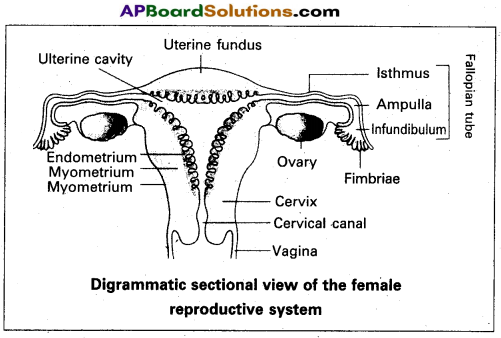
1) Ovaries : Ovaries are the primary female sex organs that produce the female gametes (ova) and several steroid hormones (ovarian hormones). A pair of ovaries is located on each side of lower abdomen. The double layered fold of peritoneum connecting the ovary with the wall of abdominal cavity is known as the meso ovarium.
The Ovaries are covered by a layer of-germinal (ovarian) epithelium. Underneath this layer, there is a dense connective tissue capsule called, ‘tunica albuginea’. The ovarian stroma is distinctly divided into an outer cortex and an inner medulla. The cortex appears more dense and granular due to numerous ovarian follicles. The medulla is a loose connective tissue with abundant blood vessels, lymphatic vessels and nerve fibres.
2) Fallopian tubes (oviducts): Each fallopian tube extends from the periphery of each ovary to the uterus and it bears a funnel shaped infundibulum, with finger like projections called ‘fifhbriae’, which help in collection of ovum after ‘ovulation’.
The infundibulum leads to a wider part of the oviduct called ‘ampulla’. The last part of the oviduct, ‘isthmus’ has a narrow lumen and it joins the uterus. Fallopian tube is the site of fertilization. It conducts the ovum or zygote towards the uterus by peristalsis. The fallopian tube is attached to the abdominal wall by a peritoneal fold called ‘meso salpinx’.
3) Uterus: The uterus is a single and it is also called womb. It is a large, muscular, highly vascular and inverted pearshaped structure present in the pelvis between the bladder and rectum. The lower narrow part through which the uterus opens into the vagina is called ‘cervix’. The cavity of the cervix is called ‘cervical canal’ which along with the vagina forms the ’birth canal’.
The wall of the uterus has three layers of tissue. The external thin membranous ‘perimetrium’, the middle thick layer of ‘myometrium’ and inner glandulas lining layer called ‘endometrium’. The endometrium undergoes cyclic changes during menstrual cycle while myometrium exhibits strong contractions during parturition.
4) Vagina : The vagina is a large, median, fibromuscular tube that extends from the cervix to the vestibule (the space between labia minora). It is lined by non-keratinised stratified squamous epithelium. It is highly vascular and opens into the vestibule by the vaginal orifice.
5) Vulva : Vulva or pudendum refers to the external genitals, of the female. The vestibule has two apertures – the upper external urethral orifice of the urethra and the lower vaginal orifice of vagina. Vaginal, orifice is covered by a mucous membrane ‘hymen’, vestibule is bound by two pairs of fleshly folds of tissue called inner ‘labia minora’ and outer larger ‘labia majora’. Clitoris is a sensitive, erectile structure, that lies at the upper junction of the two labia minora above the urethral opening. There is a cushion of fatty tissue covered by skin and pubic hair present above the labia major, called mons pubis.
Accessory reproductive glands of female : These include;
a) Bartholin’s glands: These are two glands located slightly posterior and to the left and right of the opening of the vagina. They secrete mucus to lubricate the vagina and are homologous to the bulbourethral glands of the male reproductive system.
b) Skene’s glands : These are located on the anterior wall of vagina, around the lower end of the urethra. They secrete a lubricating fluid when stimulated. The skene’s glands are homologous to the prostate gland of the male reproductive system.
c) Mammary glands : These are paired structures that contain glandular tissue and fat. The alveoli cells present in the mammary lobes of each glandular tissue secrete milk, which is stored in cavities of alveoli. The alveoli open into mammary tubes and then to mammary ducts, from there to mammary ampulla and finally connected to lactiferous duct through which milk is sucked out by the baby.
![]()
Question 21.
What is criss-cross inheritance ? Explain the inheritance of one sex linked recessive character in human beings.
Answer:
The X-linked genes are represented twice in female (because female has two ‘X’-chromosomes) and once in males, (because male has one X-chromosome). In male single X-linked recessive gene express it phenotypically, in contrast to female in which two ‘X’ linked recessive genes are necessary for the determination of a single phenotypic trait related to sex.
The recessive X-linked genes have chracteristic crisseross-inheritance.
Crisscross inheritance : The inheritance of X-linked recessive trait (genes) to his grandson (F2) through his daughter (carrier) is called crisscross inheritance. Crisscross inheritance can be explained in humans by sex-linked recessive disorder, colour blindness.
Colourblindness : Colour blindness is a particular trait in human beings render them unable to differentiate between red and green colour. The gene for this colour blindness is located on X-chromosome. Colour blindness is recessive to normal vision so that if colour blind man marries a normal vision (homozygous) woman, all the sons and daughters are normal but daughter are heterozygous, which means that these daughters would be carrier for this trait. If such carrier woman marries a man with normal vision all the daughters and half of the sons have normal vision and half of sons are colour blind.
Colour blind trait is inhereted from a male parent to his grandson through carrier daughter i.e., this trait shows crisscross inheritance
